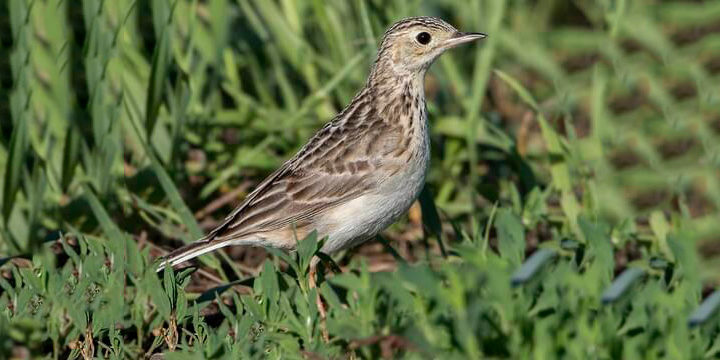Bird of The Week: Sprague’s Pipit
Scientific Name: Anthus spragueii
Population: 1.4 million
Trend: Decreasing
Habitat: Breeds and winters in large areas of short- and mixed-grass prairie.
About
The Sprague’s Pipit is a grassland songbird native to North America, with buffy, striped plumage that blends in seamlessly with its preferred habitat. Although it can be mistaken for other species such as the Vesper Sparrow or the closely related American Pipit, the Sprague’s Pipit has a thin bill, unlike the sparrow, and a more strongly streaked back than its relative, plus an unmarked face that gives it a wide-eyed look. Normally inconspicuous and solitary, the Sprague’s Pipit shines during its breeding season due to a unique courtship ritual.
Soaring Spring Displays
On its breeding grounds, the male Sprague’s Pipit becomes a star, staging vocal flight displays that can last from 30 minutes to three hours. This aerial breeding display is thought to be the longest of any bird species.
During these displays, the male rises 300 feet or more above the ground in undulating flight while singing a descending series of sweet, tinkling notes. Then, he circles above his territory on fluttering wings while still singing, before eventually descending to begin the process again.
Breeding and Feeding
Growing Up in the Grasses
Once a displaying male Sprague’s Pipit finds a mate, he defends a breeding territory and continues to spend up to three hours a day displaying. This sustained seasonal activity is often the only sign of the presence of this otherwise elusive species.
Meanwhile, the out-of-sight female builds her nest on the ground, usually in a slight depression or tucked into the side of a grass clump. The nest is a woven cup of dry stems lined with finer grasses, with longer grasses surrounding the nest incorporated into a dome that provides protection from the elements. Other ground-nesting grassland birds such as the Western Meadowlark build similarly domed nests.
The average Sprague’s Pipit clutch size is four eggs, which hatch after about two weeks. The female does most of the incubation, flushing only if approached within a few feet. She also feeds the hatchlings, which leave the nest once they can move around. Males are not known to feed either the incubating female or the nestlings. Sprague’s Pipits may raise two broods in a summer.
This grassland bird eats mainly insects and seeds, which it gleans while foraging among the grasses. It walks rather than hops, and does not pump its tail like other pipit species.
Region and Range
The Sprague’s Pipit is found only in North America, breeding on native grasslands from south-central Canada to southern Montana and northern South Dakota. It migrates south to winter on open grasslands in the southwestern United States and northern Mexico, often in areas that host other wintering grassland species such as the Chestnut-collared Longspur and Baird’s Sparrow.
Conservation
Saving a Prairie Icon
Habitat loss, mainly the conversion of native prairie for agriculture, has led to rapid declines in this species and other at-risk grassland birds such as the Long-billed Curlew. The Sprague’s Pipit is very sensitive, with populations rapidly declining after people alter grassland habitat. The species has experienced a 79-percent drop in population since 1966, when the Breeding Bird Survey first began to monitor bird population trends. Other threats to this species include pesticide use and climate change.
Roughly 85 percent of grassland birds that breed in the northern Great Plains of the United States (including the Sprague’s Pipit) spend their winters in northern Mexico. As habitat on both their breeding and wintering grounds have diminished, grassland birds have become one of the fastest-declining groups of birds native to North America.
ABC’s Migratory Birds Program and Northern Great Plains office work to stem these and other bird species declines through partnerships and the BirdScapes approach, which aims to conserve geographically linked habitats on breeding grounds, wintering grounds, and migration stopover sites.
Get Involved
Policies enacted by the U.S. Congress and federal agencies, such as the U.S. Fish and Wildlife Service, have a huge impact on migratory birds. You can help shape these rules for the better by urging lawmakers to prioritize birds, bird habitat, and bird-friendly measures. To get started, visit ABC’s Action Center.
Living a bird-friendly life can have an immediate impact on migratory birds in the United States. Doing so can be as easy as adding native plants to your garden, avoiding pesticides, and keeping cats indoors. To learn more, visit our Bird-Friendly Life page.
American Bird Conservancy and our Migratory Bird Joint Venture partners have improved conservation management on more than 8.5 million acres of U.S. bird habitat — an area larger than the state of Maryland — over the last ten years. That’s not all: With the help of international partners, we’ve established a network of more than 100 areas of priority bird habitat across the Americas, helping to ensure that birds’ needs are met during all stages of their lifecycles. These are monumental undertakings, requiring the support of many, and you can help by making a gift today.
Source: American Bird Conservancy (abcbirds.org)


